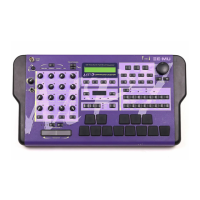MP-7 Owners Manual 215
Preset Edit Menu
Sound Start Offset, Delay & Key-up Layer
Key Up Layer - The synthesizer layers can be programmed to play when a
key is Released instead of when it is pressed. This feature has a multitude of
applications, including the simulation of key-up sounds of a harpsichord or
piano damper pedal noise. You can also create complex sounds with a
different instrument on the release. The volume of a key-up layer could be
controlled using a pedal or wheel to articulate controllable guitar squeaks
or other sounds.
The envelopes play through all six stages on a key-up layer, except that
there is no sustain. The key sustain is ignored so that the sound won’t just
keep sustaining forever when a key is released, but otherwise the envelopes
operate normally. Depending on the Key-up sound, you may have to adjust
the envelope settings for the desired response. If you can’t hear the key-up
layer, it ususally means that the Decay 2 Rate is too short.
Key up layers interact with the sustain cord destination. For example, if a
note is played with the sustain pedal held, the release layer will sound
when the sustain pedal is released.
The Key-up feature cannot be used together with Solo mode. If solo
mode is selected, the key-up trigger action will be disabled. The Key-up
feature CAN be used in conjunction with Assign Group, Mono if you want
to limit the polyphony of the key-up channel to a single channel. This is
especially useful when simulating damper pedal sounds.
The Key-up layer responds to Key-down velocity just like a normal layer.
This is done to facilitate layering with a Key-down layer. (i.e. when the Key-
down layer is softer, the Key-up layer will also be softer.)
To Program a Key-Up Layer
1. Select a preset and press the Preset Edit button.
2. Scroll to the Instrument screen and select a sound for your Key-up layer.
(For example, program Layer 1 to be your primary sound and Layer 2 your
key-up sound.)
3. Scroll to the Sound Start screen shown above using the data entry
control.
4. Select the layer of your key-up sound.
5. Move the cursor to the Delay field and turn the data entry control
counter-clockwise until the display changes to read “key-up” as shown
above.
6. Play the keyboard or keypads. You should now hear your key-up sound
when you release the key.
L2
SOUND START DELAY
0 keyup
Tu rn data
entry control
fully CCW.

